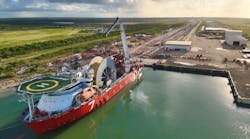Offshore staff
ABU DHABI, UAE – DNV GL has updated its offshore standard DNV-OS-F101, the company announced at the ADIPEC exhibition this week.
The standard, first issued in 1976, has been re-named DNVGL-ST-F101. Around 65% of all new projects globally have been designed in compliance with the standard, the company added.
Its revision takes into account the findings of various joint industry projects (JIPs) such as DNV GL’s on providing guidance for installation of rigid and flexible pipes, umbilicals, and power cables.
This outlined the challenges that need to be addressed during planning and design of marine operations and the common basis for installation design ofpipelines, umbilicals, and cables.
Rigid pipeline criteria developed from the JIP have been accommodated in the new standard.
DNVGL-ST-F101 also incorporates input from another JIP on pipe-in-pipe (PiP) systems, which examined issues related to existing PiP systems and the shortcomings of current design standards for these types of systems.
The standard now reflects the conclusions on selection of safety classes, limit-state criteria, additional guidelines specific to PiP, and code breaks.
Various requirements related to linepipe fabrication, welding and non-destructive testing have also been updated due to advances in technologies, and are based on hands-on experience at DNV GL’s 14 laboratories and among various field inspectors.
These laboratories support the pipeline industry with material testing, corrosion testing, full scale testing, flow testing and failure analysis.
Another change in the standard is that requirements for replacement of the system pressure test are now more flexible and do not rule out pipelines in shallower water.
Removing the need to fill the empty pipeline with water can significantly reduce the cost for pipeline operators, DNV GL said, although additional work will be necessary to prove an equivalent safety level.
11/16/2017




